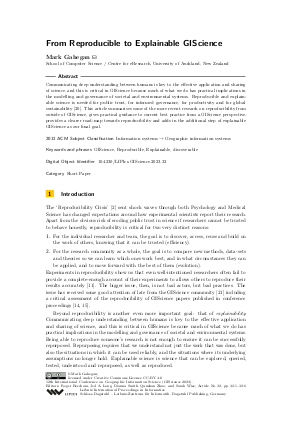From Reproducible to Explainable GIScience (Short Paper)
Author Mark Gahegan
-
Part of:
Volume:
12th International Conference on Geographic Information Science (GIScience 2023)
Part of: Series: Leibniz International Proceedings in Informatics (LIPIcs)
Part of: Conference: International Conference on Geographic Information Science (GIScience) - License:
 Creative Commons Attribution 4.0 International license
Creative Commons Attribution 4.0 International license
- Publication Date: 2023-09-07
File

PDF
LIPIcs.GIScience.2023.32.pdf
- Filesize: 431 kB
- 6 pages
Document Identifiers
Subject Classification
ACM Subject Classification
- Information systems → Geographic information systems
Keywords
- GIScience
- Reproducible
- Explainable
- discoverable
Metrics
- Access Statistics
-
Total Accesses (updated on a weekly basis)
0PDF Downloads0Metadata Views
Abstract
Communicating deep understanding between humans is key to the effective application and sharing of science, and this is critical in GIScience because much of what we do has practical implications in the modelling and governance of societal and environmental systems. Reproducible and explainable science is needed for public trust, for informed governance, for productivity and for global sustainability [Vicente-Saez et al., 2021]. This article summarises some of the more recent research on reproducibility from outside of GIScience, gives practical guidance to current best practice from a GIScience perspective, provides a clearer road-map towards reproducibility and adds in the additional step of explainable GIScience as our final goal.
Cite As Get BibTex
Mark Gahegan. From Reproducible to Explainable GIScience (Short Paper). In 12th International Conference on Geographic Information Science (GIScience 2023). Leibniz International Proceedings in Informatics (LIPIcs), Volume 277, pp. 32:1-32:6, Schloss Dagstuhl – Leibniz-Zentrum für Informatik (2023)
https://doi.org/10.4230/LIPIcs.GIScience.2023.32
BibTex
@InProceedings{gahegan:LIPIcs.GIScience.2023.32,
author = {Gahegan, Mark},
title = {{From Reproducible to Explainable GIScience}},
booktitle = {12th International Conference on Geographic Information Science (GIScience 2023)},
pages = {32:1--32:6},
series = {Leibniz International Proceedings in Informatics (LIPIcs)},
ISBN = {978-3-95977-288-4},
ISSN = {1868-8969},
year = {2023},
volume = {277},
editor = {Beecham, Roger and Long, Jed A. and Smith, Dianna and Zhao, Qunshan and Wise, Sarah},
publisher = {Schloss Dagstuhl -- Leibniz-Zentrum f{\"u}r Informatik},
address = {Dagstuhl, Germany},
URL = {https://drops.dagstuhl.de/entities/document/10.4230/LIPIcs.GIScience.2023.32},
URN = {urn:nbn:de:0030-drops-189279},
doi = {10.4230/LIPIcs.GIScience.2023.32},
annote = {Keywords: GIScience, Reproducible, Explainable, discoverable}
}
Author Details
References
-
S. T. Arundel and W. Li. The Evolution of Geospatial Reasoning, Analytics and Modeling In: The Geographic Information Science and Technology Body of Knowledge, John P. Wilson (Ed.). UCGIS, 2021.

- M Baker. 1,500 scientists lift the lid on reproducibility. Nature, 533:452-454, 2016. URL: https://doi.org/10.1038/533452a.
-
M. Bunge. How does it work? the search for explanatory mechanisms. Philosophy of the social sciences, 34(2):182-210, 2004.

-
Y.H. Cao, C.J. Yi, and Y.H. Sheng. Geographic process modeling based on geographic ontology. Open Geosciences, 10(1):782-796, 2018.

- M. Clerx, M. Cooling, J. Cooper, A. Garny, K. Moyle, D. Nickerson, P. Nielsen, and H Sorby. Cellml 2.0. Journal of Integrative Bioinformatics, 17(2):2020-0021, 2020. URL: https://doi.org/10.1515/jib-2020-0021.
- A. J. Drummond, K. Chen, F. K. Mendes, and D. Xie. Linguaphylo: a probabilistic model specification language for reproducible phylogenetic analyses. bioRxiv, 2022.08.08.503246, 2022. URL: https://doi.org/10.1101/2022.08.08.503246.
- A. Ellerm, B. Adams, M. Gahegan, and L. Trombach. Enabling livepublication. In IEEE 18th International Conference on e-Science, Salt Lake City, UT, USA. IEEE Computer Society, 2022. URL: https://doi.org/10.1109/eScience55777.2022.00067.
- M. Gahegan. Our gis is too small. The Canadian Geographer / Le Géographe canadien, 62:15-26, 2018. URL: https://doi.org/10.1111/cag.12434.
- M. F. Goodchild. Commentary: general principles and analytical frameworks in geography and giscience. Annals of GIS, 28(1):85-87, 2022. URL: https://doi.org/10.1080/19475683.2022.2030943.
-
R Harris. The semantics of science. A-and-C Black, 2005.

-
T. Hothorn and F. Leisch. Case studies in reproducibility. Briefings in bioinformatics, 12(3):288-300, 2011.

- K. Janowicz, A. Haller, S. Cox, D. Phuoc, and M. Lefrancois. Sosa: A lightweight ontology for sensors, observations, samples, and actuators. Journal of Web Semantics, 2018. URL: https://doi.org/10.2139/ssrn.3248499.
-
S. Levinson. Pragmatics. Cambridge University Press, 1983.

- D. Nüst, C. Granell, B. Hofer, M. Konkol, F.O. Ostermann, R. Sileryte, and V. Cerutti. Reproducible research and giscience: an evaluation using agile conference papers. PeerJ, 13(6):p.e 5072, 2018. URL: https://doi.org/10.7717/peerj.5072.
-
Frank O. Ostermann, Daniel Nüst, Carlos Granell, Barbara Hofer, and Markus Konkol. Reproducible research and giscience: An evaluation using giscience conference papers. In International Conference Geographic Information Science, 2020.

-
Physiome. The physiome journal. Physiome, 1(1):1, 2019.

-
H. Rijgersberg, M. Van Assem, and J.L. Top. Ontology of units of measure and related concepts. Semantic Web, 4:3-13, 2013.

-
F.J. Tapiador, A. Navarro, V. Levizzani, E. García-Ortega, G.J. Huffman, C. Kidd, P.A. Kucera, C.D. Kummerow, H. Masunaga, W.A. Petersen, and R. Roca. Global precipitation measurements for validating climate models. Atmospheric Research, 197:1-20, 2017.

-
N. Turner Lee, P. Resnick, and G. B. Wednesday. Algorithmic bias detection and mitigation: Best practices and policies to reduce consumer harms. Brookings Institute, 2019.

- R. Vicente-Saez, R. Gustafsson, and C. Martinez-Fuentes. Opening up science for a sustainable world: An expansive normative structure of open science in the digital era. Science and Public Policy, 48(6):799-813, 2021. URL: https://doi.org/10.1093/scipol/scab049.
-
J.P. Wilson, K. Butler, S. Gao, Y. Hu, W. Li, and D.J. Wright. A five-star guide for achieving replicability and reproducibility when working with gis software and algorithms. Annals of the American Association of Geographers, 111(5):1311-1317, 2021.

-
D. J. Wright, M. F. Goodchild, and J. D. Proctor. Demystifying the persistent ambiguity of gis as "tool" versus "science". The Annals of the Association of American Geographers, 87(2):346-362, 1997.

